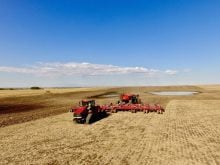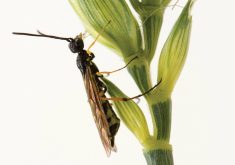Despite unfavorable weather, producers were able to make good harvest progress last week. Ninety per cent of the crop is now in the bin, up from 83 per cent last week but remains behind the five-year (2014-2018) average of 96 per cent for this time of year. Many areas received mixed precipitation that has stalled most harvest operations in the province. Producers remain hopeful that they will complete harvest this fall.
Harvest progress was made in most regions last week. The west-central and northeastern regions are the most advanced with 96 per cent of the crop now combined. The south west and northwest regions have 90 per cent combined, the southeast region 88 per cent and the east-central region 82 per cent.
Read Also

Claas brings 1000 Series SP forage harvesters to Canada
In mid-August, Claas unveiled its new line of Jaguar forage harvesters at an event in Visalia, California, deep in the heart of that state’s dairy region.
Ninety-seven per cent of mustard, 96 per cent of canary seed, 94 per cent of barley, 93 per cent of chickpeas, 92 per cent of spring wheat, 90 per cent of durum, 88 per cent of canola, 76 per cent of soybeans and 62 per cent of flax are now in the bin. An additional six per cent of the crop is swathed or is ready to be straight-cut.
Estimated average crop yields for the province are 38 bushels per acre for canola, 22 bushels per acre for flax, 1,024 pounds per acre for mustard, 28 bushels per acre for soybeans, 38 bushels per acre for durum, 45 bushels per acre for spring wheat, 66 bushels per acre for barley, 834 pounds per acre for canary seed and 1,420 pounds per acre for chickpeas.
Mixed precipitation consisting of rain and snow was received across most of the province last week. The Lake Lenore area reported 60 mm and the Rocanville area 42 mm. Provincially, topsoil moisture conditions on cropland are rated as 13 per cent surplus, 80 per cent adequate, five per cent short and two per cent very short. Hay land and pasture topsoil moisture is rated as six per cent surplus, 83 per cent adequate, nine per cent short and two per cent very short. Some fields remain saturated with excess water, particularly in southern and east-central regions.
The majority of crop damage this past week was due to strong winds and frost. Geese and wildlife continue to cause damage by feeding on swathed crops. There also continues to be many reports of significant downgrading at the elevator due to sprouting. The crop is coming off is tough or damp and is being placed into aeration bins and grain dryers. Farmers are busy drying grain and hauling bales.















